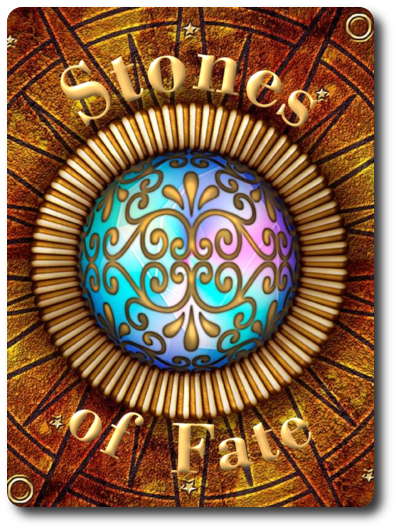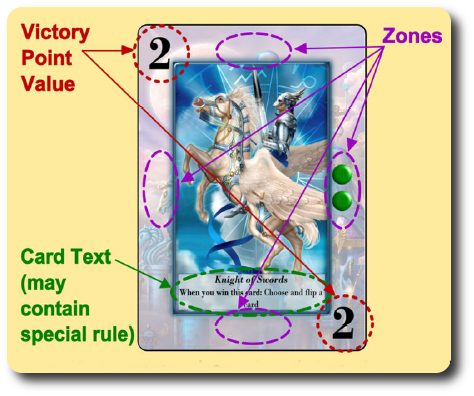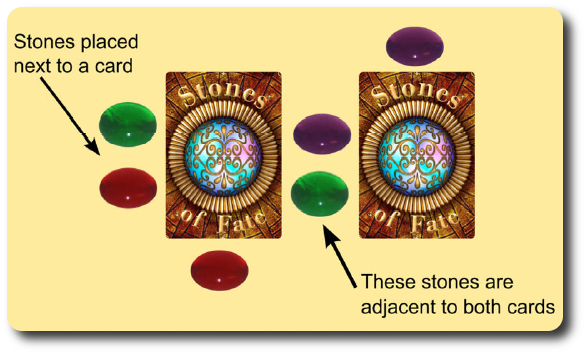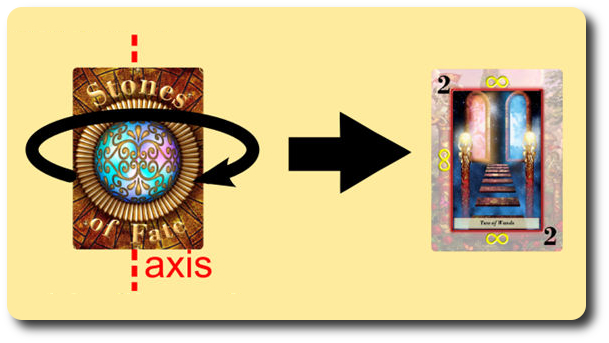Please Take Note: This is a review of the game’s final prototype. The art, game bits, and the rules discussed are all subject to change. The game is being reviewed on the components and the rules provided with the understanding that “what you see is not what you might get” when the game is published. If you like what you read and want to learn more, we encourage you to visit the game’s web page or visit the Kickstarter campaign. Now that we have all that disclaimer junk out of the way, on with the review!

The Basics:
- For ages 8 and up (publisher suggests 12+)
- For 2 to 4 players
- Approximately 30 minutes
Geek Skills:
- Counting & Math
- Logical & Critical Decision Making
- Reading
- Memorization
- Strategy & Tactics
- Risk vs. Reward
- Hand/Resource Management
- Bluffing and Misdirection
- Worker Placement & Area Control
Learning Curve:
- Child – Easy
- Adult – Easy
Theme & Narrative:
- In this game of memorization and subtle manipulation, timing is everything
Endorsements:
- Gamer Geek approved!
- Parent Geek approved!
- Child Geek approved!
Overview
Life is a mystery and an adventure. We can clearly see the choices put in front of us, but not the results of the choices we have not yet made. Some believe in fate and some believe that the future is not yet written. In the end, it really doesn’t matter because we can only take action on what we know and what is before us. In this game, what is before you is a mystery, but through subtle game play and manipulation, even fate can be controlled. Nothing is for certain.
Stones of Fate, designed by Luke Laurie and to be published by Cosmic Wombat Games, will reportedly be comprised of 78 cards, 4 Player Reference cards, and 20 Stones (acrylic, in 4 different colors, 5 stones per color). As this is a review of a prepublished game, we will not comment on the game component quality. But, honestly, what we were sent felt, looked, and played like “the real deal”. Stunning artwork (that you might or might not appreciate) and exceedingly tight rules. The game is done, in my opinion.

A Quick Look at the Cards
The 78 cards in Stones of Fate are designed to look like a Tarot card deck. The deck itself contains 5 different suits. These are Coins, Cups, Swords, Wands, and the Major Arcana. The Coins, Cups, Swords, and Wands suits have 14 cards each bearing names like “Six of Wands” and “Ace of Cups”. The Major Arcana suit contains 22 cards bearing names like “Death”, “Justice”, and “The World”. For anyone who is knowledgable about Tarot cards, they’ll instantly recognize that Stones of Fate is a fully functioning Tarot deck, but none of the traditional (and nontraditional) uses of the Tarot cards are actually used in the game. Stones of Fate is not a game about fortune-telling or a backdoor into the occult. That must be firmly understood. In fact, the Tarot aspect of the game is really just there for window dressing. Any supposed divine meaning of each card is not brought to the forefront whatsoever.
What is important to note about the cards is how much information they contain. Each card has 4 “Zones”. These are, as you look at the card’s face, the top, bottom, left, and right edges. These are very important to game play as we will learn shortly. Some of the cards might also contain special rules. These will trigger effects during the game when the card is either flipped or won by a player. The last bit of important information is the victory point value of the card. Some show positive numbers and some negative.

The Zones of the cards require a bit more explanation as they are a major aspect of the game play. A Zone and the Stones that are adjacent to it are used to determine who wins the cards. Each of the Zones are summarized here.
Power Zone
Any Stones in these Zones count towards winning the card. This Zone is depicted by the infinity symbol (the number “8” turned on its side).
Keystone Zone
Any Stones adjacent to the Keystone Zones will count towards winning the card, but the player must have the EXACT number of Stones adjacent to this Zone as the number of Stones depicted on the card’s edge. For example, if the Keystone Zone showed 3 Stones, the player must have 3 (no more, no less) Stones adjacent to that Zone for it to count towards winning the card.
Forbidden Zone
Any Stones adjacent to this Zone not only do not count towards points, but also completely nullify any and all stones of the same color located adjacent to any other Zone belonging to the card. In short, if a player has a Stone adjacent to a Forbidden Zone, they will never, ever win the card. This Zone is depicted by a red “0” with a line slashed through its middle.
Opportunity Zone
This Zone does not count towards winning a card, but it does reward players who have placed Stones adjacent to this Zone all the same. Any player who has at least 1 Stone adjacent to the Opportunity Zone when the card is revealed will be able to draw 1 card from the draw deck. A player will only ever draw 1 card, regardless of how many Stones they have located adjacent to one or more Opportunity Zones on the card. This is actually a mixed bag, as the draw deck will either award the player a card that is worth points or a card that reduces points. Either way, it’s a gamble. The Opportunity Zone is depicted by a triangle with 2 slashes on either side of it.
Blank Zone
This zone is depicted with no icon whatsoever. It is blank. Any Stones adjacent to this Zone when the card is revealed do not count for or against the players who own them. They are, essentially, ignored.
Game Set Up
To set up the game, first take the 78 cards and shuffle them. Depending on the number of players in the game, you will now deal out a number of cards (face-down) from the deck. For a 2-player game, deal out 22 cards; for a 3-player game, deal out 33 cards; and for a 4-player game, deal out 41 cards. Again, deal them face-down creating a new deck of cards. Any cards not added to the new deck are removed for the duration of the game.
Note: Some of the artwork on the cards contains nudity. Nothing terribly scandalous, I assure you, but a Parent Geek might want to take a quick moment to go through the deck and remove the cards that contain the artwork that makes them feel uncomfortable. When we played the game, there were only 5 cards that made our Parent Geeks squirm. The very good news is that these cards can be removed from the game WITH NO NEGATIVE IMPACT to the game play whatsoever. All the cards added to the deck to be played with are always random and players will never use all 78 of the cards. This also allows the players to tailor their deck if there are cards in particular that they always want to play with or cards they never want to see on their gaming table.
Second, have each player collect 5 Stones of the same color and place them in front of them. Players should also take a Player Reference card if needed.
Third, deal out the cards, face-down, to the table in a grid formation. This is referred to as the “spread”. If playing a 2-player game, create a 2 x 3 card spread. If playing with 3 or 4 players, create a 3 x 3 card spread. Place the remaining cards in the deck face-down next to the spread, leaving room for a discard pile next to it. This will be the draw deck.
That’s it for game set up! Time to play!
Tempting Fate
The game is played in turns with no set number of turns or rounds in a single game. On a player’s turn, they will take 2 actions out of a possible 3. All of the actions can be done more than once per turn and the order in which they are taken is up to the player. Each action is summarized here.
Peek at a Card
This action allows the player to select any card in the spread and take a look at its face. This should be done so that only the player can see the card. Players should take special note of the Zones on the edges of the card, the victory point value, and any special rules that will be triggered when the card is revealed or won. When the player is done looking at the card, they should place it face-down in the same position and orientation as they found it.
Move a Stone
This action allows the player to move any 1 Stone to any of the four edges of a card located on the spread. When the game starts, every player will have their 5 Stones in front of them. As the game continues, the Stones will be shifting positions many, many times on the spread. There are no limits to the number of Stones that can be placed on any card’s edge. Any Stones adjacent to other cards also count towards that card’s Zone if revealed.

Flip a Card
This action allows the player to reveal a card on the spread. When revealing a card, make sure you turn it so it “spins” on its vertical access. The very first thing that all players should do is review the card for any special rules. If the card states “When you FLIP this card…”, whatever the card states should be done is only done by the player who revealed the card. The card is now scored by looking at the four Zones and counting the Stones as required. If one player wins the card (by virtue of having the most “scorable” Stones adjacent to it), they collect the card and place it in front of them in a pile, face-up. If the card has any special rules that state “When you WIN this card…”, whatever the card states should be done is only done by the player who won the card. If no player wins the card (by virtue of none of the players having any Stones that count as “scorable” or there is a tie), the card is simply discarded. When a card is removed, it is immediately replaced by drawing 1 card from the draw deck and placing it face-down in the same spot the card before it was removed. This card should not be looked at before it is placed.

In the event that a flipped card triggers multiple special rules from other cards, the player who flipped the card resolves each card in turn. All cards that are flipped will be scored.
After the player takes their 2 actions, the next player in turn order sequence now goes.
Beating Fate
The game continues until the last card is drawn from the draw deck. The game immediately ends and all the cards on the spread are revealed (again, make sure you turn the cards on their vertical axis). Ignore all special rules that are triggered when a card is flipped or won and score each card according to its Zones and the Stones that are adjacent to them. Any cards won are collected by the player and added to their pile of won cards.
All the players now count the victory point values on their cards starting with “Zero”. Depending on the card, the number of victory points the player will count will increase or decrease. It is perfectly possible to have 10 cards and have negative points, for example. Additionally some of the suits give additional bonus points if the player has collected so many cards of a specific suit. For example, the “Page of Wands” is worth only 1 victory point at the end of the game, but if the player has collected 3 or more Wand cards, the “Page of Wands” is worth 3 victory points.
The player with the most victory points is the winner!
To learn more about Stones of Fate and read the full rules, visit the game’s web page or visit the Kickstarter campaign.
Prediction
Stones of Fate is, at its core, a memory game. But let’s take a closer look. There is a lot of strategic timing that is necessary to win and a number of tactics to utilize to bluff, control, and win cards. Yes, memory is a key element to the game, but so is timing and watching your opponents very, very carefully. Stones of Fates is a game of layers, and just reading the rules does not give this game any justice. Of course, that’ll make teaching the game all the more entertaining as I attempt to educate my players on the brutal, but subtle nature of the game.
I predict this game will do very well with all our groups. There are layers to Stones of Fate, and each time you dig a bit deeper, the game opens up that much wider. This means the game has depth and depth is one of the most important things to Gamer Geeks, but it is also important to Parent Geeks because they want a game that doesn’t waste their time and makes them think. And for the Child Geeks, they want a game that is easy to learn and fun to play. Stones of Fate would appear to be all these things.
Teaching the game is not hard, but do take the time to make sure everyone understands how the Stone placement works and how the cards are flipped. If you don’t, you are going to have some upset players. You should also let them know it is perfectly reasonable (and encouraged) to flip over cards with the single purpose of awarding them to other players. This is because there are cards in the spread a player will most certainly not want. Getting ride of them is important, but the timing is even more so. You want to do all you can to get the “bad cards” in the piles of the players who have the most points. When we taught the game to our players, the only questions they had were about special card abilities. Again, just make sure they understand that the card only initiates its special ability if it is flipped or won, and that’s it.
After teaching the game to my oldest little geek, he was excited to play it. He’s played much more complicated games, and memory games tend to be on of his specialities. When I asked him what he thought of Stones of Fate so far, he enthusiastically responded.
“A really neat looking game and I know I am going to do well. Let’s play!” ~ Liam (age 8)
Yes, the game is neat looking. Let’s play it and see if our enthusiasm is warranted.
Final Word
The Child Geeks did a great job with this game. The older Child Geeks in particular showed some shrewd cunning in their game play that greatly pleased the Parent Geeks who observed. For those Child Geeks who realized that it was just as good to force the collection of a card onto an opponent as it was to collect cards themselves, their level of competitive game play was exceedingly high. So much, in fact, that a few of the younger Child Geek started to get pretty testy. In fact, one Child Geek got outright angry when another player “awarded” them a card from the spread they didn’t want. Excellent stuff. The only issue the Child Geeks had with the game dealt with some of the card timing. During one game, a card was revealed that flipped one card that forced the flip of another card, which then forced yet another card to flip. The game rules suggest how you should handle this rare situation, but it was still a bit complicated at first. Regardless, the Child Geeks all voted to approve of Stones of Fate and found it to be a fun and challenging game that solicited as much growls of anger as it did cheers of joy.

My little geek peeks at a card for a long moment – he had the perfect Poker face
The Parent Geeks also really enjoyed the game and found it not only to be an excellent game at their family gaming table, but also as a game they would happily play with their peers. Stones of Fate is very casual, but does have a lot of depth to it. It is because of this that the game can be played in a loud room, but still requires all the players to pay close attention. Especially when playing it against particularly competitive players. According to one Parent Geek, “I really like this game because I can control my points and my opponent’s.” And from another Parent Geek, “the biggest challenge in this game is not remembering where one card is, but remembering how many cards your opponents’ have won.” All the Parent Geeks greatly enjoyed their time with the game, with the one negative comment focused on the nudity in some of the card art. Once I demonstrated that the cards could be removed without causing any negative impact to the game, none of the Parent Geeks mentioned it again. They all voted to approve of Stones of Fate and looked forward to playing it again as soon as possible.
The Gamer Geeks ranged from “It’s OK” to “Wow, there’s a lot more to this game than I thought!” When I first introduced this game to some of the Gamer Geeks, I wasn’t getting a good vibe from them and even mentioned to the game designer that the Gamer Geeks weren’t going to give it their endorsement. Then, after a few days of not playing it, some of the Gamer Geeks started to ask for it. Turns out that their initial impressions, while not grandiose by any means, were actually very positive. So positive that they wanted to play the game again. Play it we did and the more they played it, the more they liked it. According to one Gamer Geek, “I really like this game for two very important reasons. First, it’s different every time you play it. Second, every time I play it, I am always challenged.” The only Gamer Geeks who did not approve it were those who only tried it once. Every Gamer Geek who played it 2 or more times approved it without a second thought. Because we had more Gamer Geeks say they approved the game than those who did not, Stones of Fate earned the Gamer Geek’s approval!

Gamer Geek Karl contemplates his next move – his Poker face was so-so
I really like Stones of Fate. It’s an easy game to learn and a lot of fun to play. It’s perfect for game fillers with my Gamer Geek friends, super for an evening with the family around the gaming table, and very enjoyable when my oldest little geek wants a strategic and tactical card game for just the two of us. I have not yet had one “bad game” with Stones of Fate and every time I play it, I like it a bit more. Unfortunately, the artwork for this game is going to turn some people off. A number of our players immediately determined the value of the game based on the artwork alone. This made their initial game playing experience less than a positive one, obviously, but for those who worked through it they found a game they rather enjoyed.
Stones of Fate is strategic. Stones of Fate is tactical. Stones of Fate is fun. Lots of fun. It’s highly portable, easy to play, easy to teach, and quick. Very quick. I once played 3 games in a row in less than an hour. Awesome. I highly recommend this game to anyone who enjoys a good card game where strategic and tactical play is necessary while remembering not only the cards on the table, but also what your opponents’ have collected. There’s a lot of information to be learned from looking at the cards, but also from simply watching your opponents’ Stones. The game has a surprising amount of depth and a lot of replay value. Expect to bluff a lot, attempt to force your opponent’s hand, and don’t think for a moment that you want to collect every card. I am most pleased with the game and would happily play it whenever asked to.
This game was given to Father Geek as a review copy. Father Geek was not paid, bribed, wined, dined, or threatened in vain hopes of influencing this review. Such is the statuesque and legendary integrity of Father Geek.



